Misterije svemira
Re: Misterije svemira
Meni ovo liči na običan šatl.
Tapatalk
Tapatalk
Re: Misterije svemira
Đubretarac
Re: Misterije svemira
Tačno, u pitanju je običan space shuttle. Ja sam malo bio zaboravio kako izgleda. 
Ђенерал Јанковић
Re: Misterije svemira
Na današnji dan 1961. Gagarin je postao prvi čovek u svemiru.








Re: Misterije svemira
Dosadašnje svemirske misije.


Najgore je svađati se sa budalom. Prvo te spusti na svoj nivo, a onda te dotuče iskustvom...



- maxer
- Postovi: 6672
- Pridružio se: 13 Jan 2012, 01:36
- Garaža: Ford Focus II Mk2 1.6 16V
- Lokacija: Zaječar
Re: Misterije svemira
Približavamo se velikom događaju: 04. jula će NASA pokušati da uvede u orbitu oko Jupitera, svemirsku sondu nazvanu JUNO.
JUNO je velika i super-teška (preko 3 tone) ili bolje rečeno oklopljena svermirska letelica (zbog enormne elektromagnetne sile i radijacije Jupitera, koja bi mogla za čas da uništi elektronsku opremu).
JUNO bi trebala da u 37 kruženja oko Jupitera (veoma izražene elipsoidne polarne orbite - kruži od severnog ka južnom polu, pošto je na polovima svakog magneta - sila najslabija), obavi sva planirana snimanja i da zatim "padne" na Jupiter, kako bi bilo sprečeno da "nesterilna" letelica (ili njeni delovi) možda padnu na neki od Jupiterovih satelita.
https://youtu.be/ITPizr7Pqgg?list=PLTiv ... DXYiYnJUOE
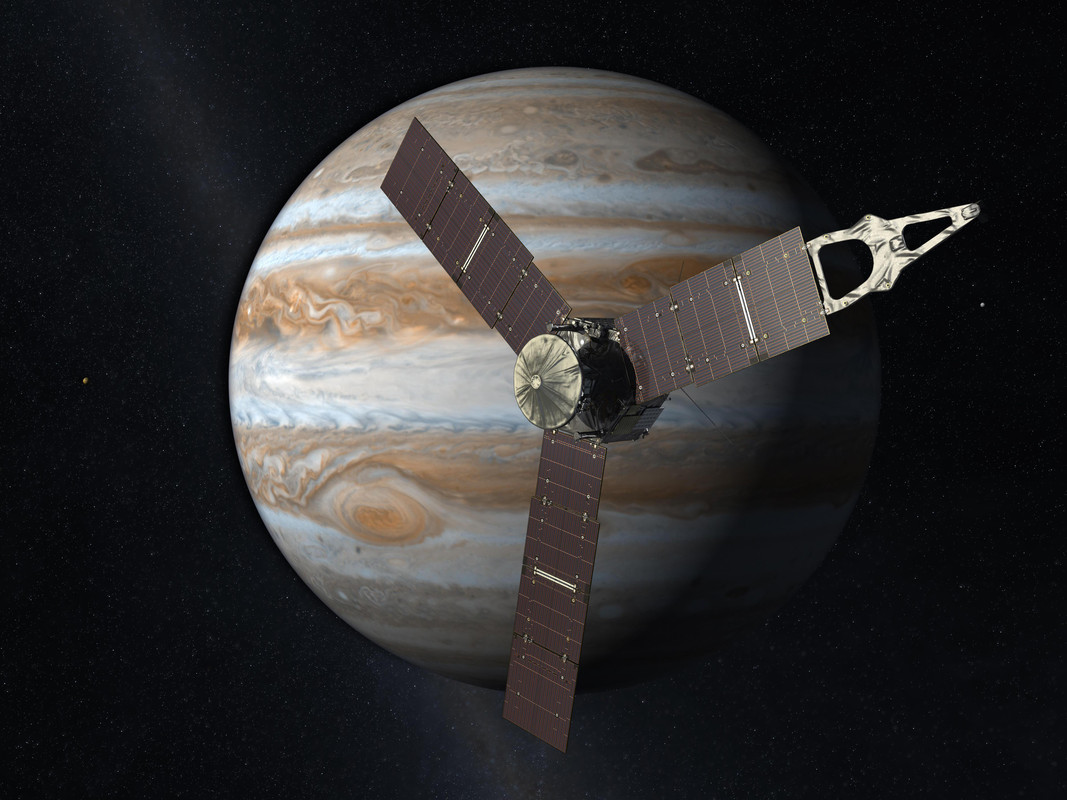
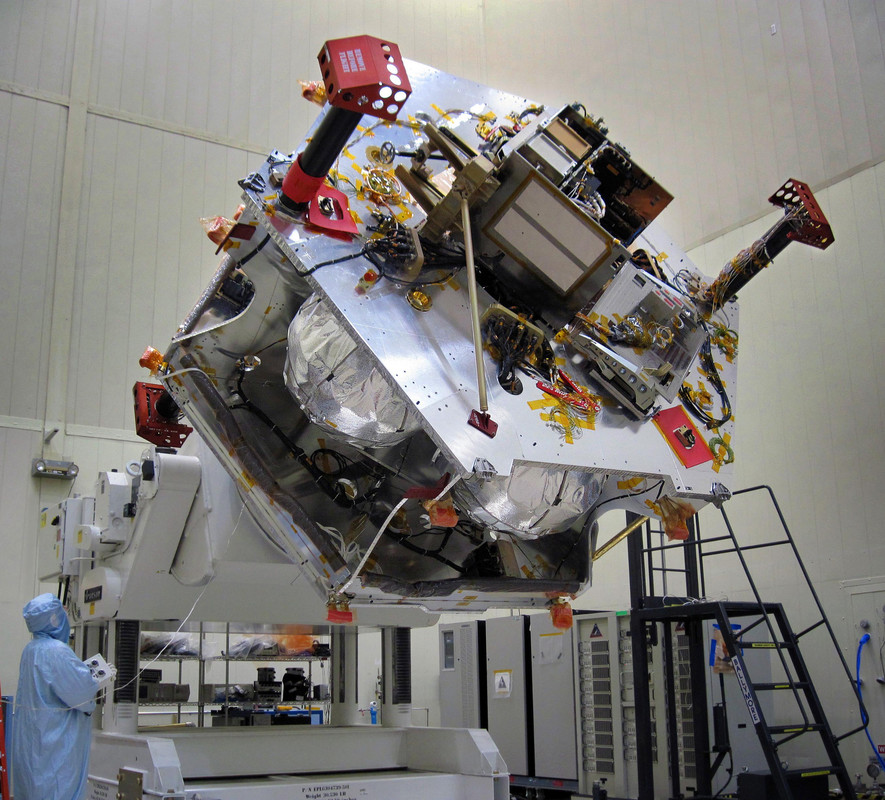
Juno je do Jupitera morala stići pomoću tehnologije popularno znane kao "gravitaciona praćka", jer čak i najjača raketa-nosač nije imala snage da je ubrza toliko da ona "pravom" linijom stigne do Jupitera. U prvom kruženju, Juno je odletela do iza Marsa, da bi je zatim gravitacija Sunca povukla nazad. Tamo je izvršena složena manevarska tehnika (sa internim hemijskim motorima, koji služe isključivo za manevrisanje) kojom je letelica postavljena u poziciju da se eliptičnom putanjom vrati ka Zemlji, prođe izuzetno blizu nje (na svega 500 km) i gravitacionim poljem Zemlje bude bačena prema Jupiteru, sa dodatnim ubrzanjem koje je procenjeno na +70% osnovne brzine dobijene od rakete-nosača. Samo da napomenem da je Jupiter izuzetno daleko tj. 5 distanci Zemlje od Sunca ili grubo rečeno: koliko je Mars na najudaljenijoj tački od Sunca, još toliko treba preći da se dođe do Jupitera.
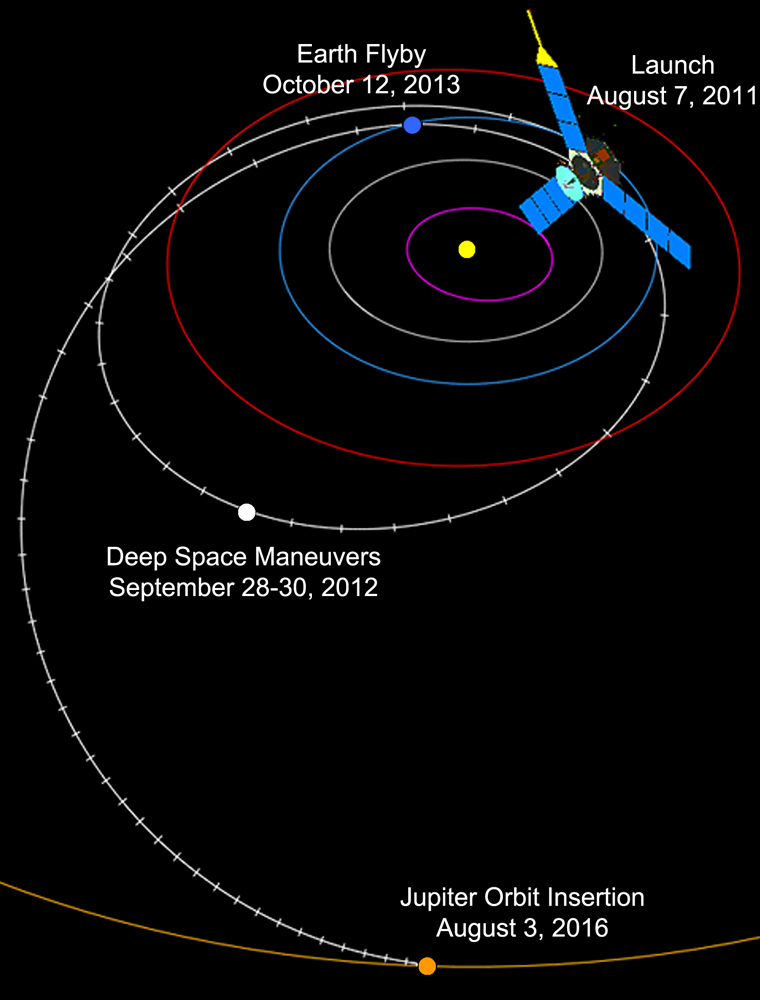
JUNO je velika i super-teška (preko 3 tone) ili bolje rečeno oklopljena svermirska letelica (zbog enormne elektromagnetne sile i radijacije Jupitera, koja bi mogla za čas da uništi elektronsku opremu).
JUNO bi trebala da u 37 kruženja oko Jupitera (veoma izražene elipsoidne polarne orbite - kruži od severnog ka južnom polu, pošto je na polovima svakog magneta - sila najslabija), obavi sva planirana snimanja i da zatim "padne" na Jupiter, kako bi bilo sprečeno da "nesterilna" letelica (ili njeni delovi) možda padnu na neki od Jupiterovih satelita.
https://youtu.be/ITPizr7Pqgg?list=PLTiv ... DXYiYnJUOE


Juno je do Jupitera morala stići pomoću tehnologije popularno znane kao "gravitaciona praćka", jer čak i najjača raketa-nosač nije imala snage da je ubrza toliko da ona "pravom" linijom stigne do Jupitera. U prvom kruženju, Juno je odletela do iza Marsa, da bi je zatim gravitacija Sunca povukla nazad. Tamo je izvršena složena manevarska tehnika (sa internim hemijskim motorima, koji služe isključivo za manevrisanje) kojom je letelica postavljena u poziciju da se eliptičnom putanjom vrati ka Zemlji, prođe izuzetno blizu nje (na svega 500 km) i gravitacionim poljem Zemlje bude bačena prema Jupiteru, sa dodatnim ubrzanjem koje je procenjeno na +70% osnovne brzine dobijene od rakete-nosača. Samo da napomenem da je Jupiter izuzetno daleko tj. 5 distanci Zemlje od Sunca ili grubo rečeno: koliko je Mars na najudaljenijoj tački od Sunca, još toliko treba preći da se dođe do Jupitera.

Re: Misterije svemira
Genijalno.
Tapatalk
Tapatalk
- maxer
- Postovi: 6672
- Pridružio se: 13 Jan 2012, 01:36
- Garaža: Ford Focus II Mk2 1.6 16V
- Lokacija: Zaječar
Re: Misterije svemira
Na ovom grafiku se vidi koliko i zašto će biti elipsoidna orbita JUNO oko Jupitera (da bi koliko je to moguće izbegao pojas zračenja oko Jupitera).
U najbližoj tački će leteti na svega 4100-4200km iznad oblaka Jupitera, što je suludo blizu, za jednu tako ogromnu planetu.
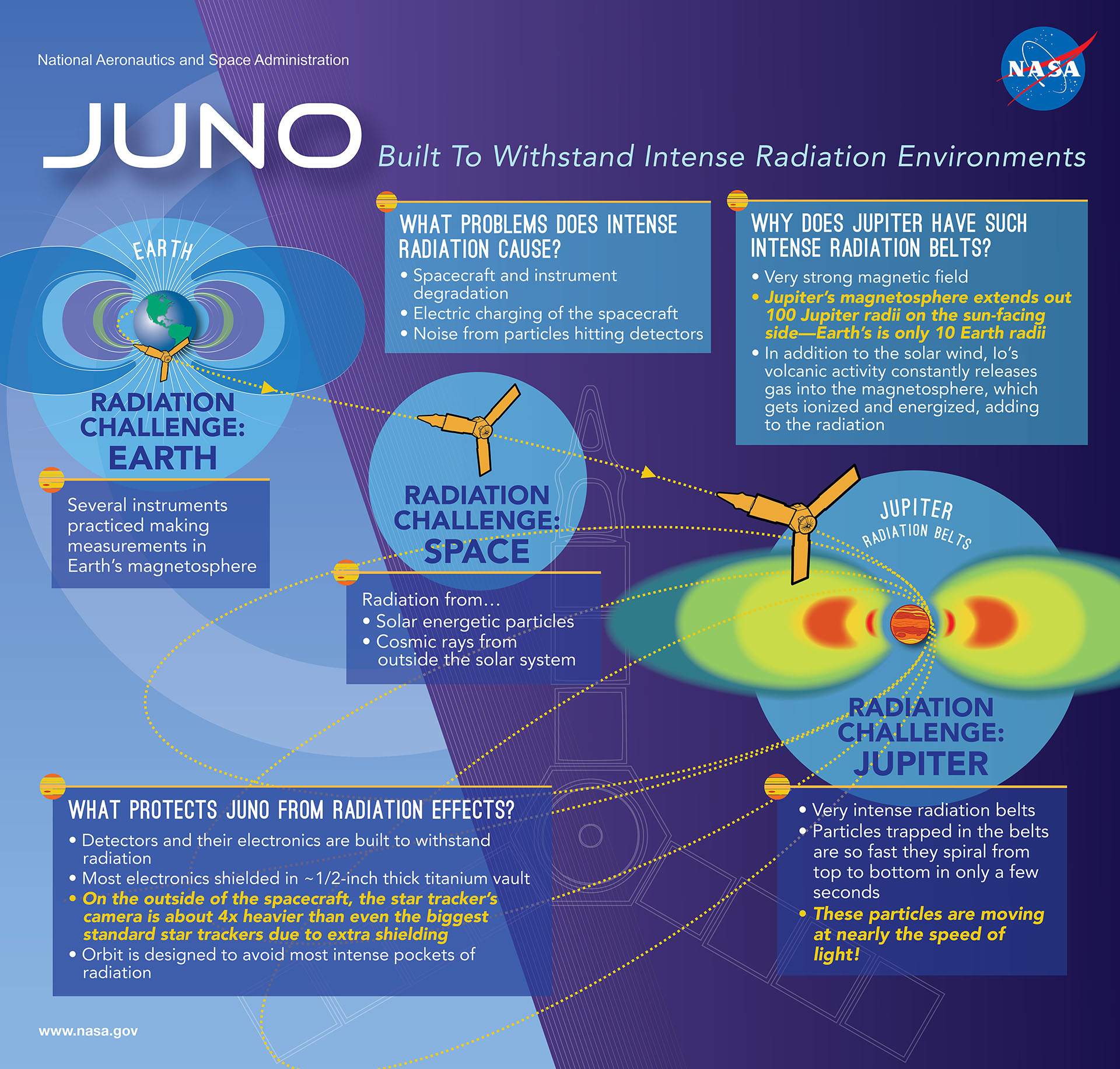
Trenutno pričaju o JUNO misiji, na NASA televiziji:
https://www.nasa.gov/multimedia/nasatv/ ... tml#public
U najbližoj tački će leteti na svega 4100-4200km iznad oblaka Jupitera, što je suludo blizu, za jednu tako ogromnu planetu.

Trenutno pričaju o JUNO misiji, na NASA televiziji:
https://www.nasa.gov/multimedia/nasatv/ ... tml#public
- maxer
- Postovi: 6672
- Pridružio se: 13 Jan 2012, 01:36
- Garaža: Ford Focus II Mk2 1.6 16V
- Lokacija: Zaječar
Re: Misterije svemira
USPELI SU: JUNO JE U ORBITI OKO JUPITERA !!! 

Trenutno je konferencija za štampu na NASA TV (uživo) https://www.nasa.gov/multimedia/nasatv/ ... tml#public
July 5, 2016
RELEASE 16-071
NASA's Juno Spacecraft in Orbit Around Mighty Jupiter
After an almost five-year journey to the solar system’s largest planet, NASA's Juno spacecraft successfully entered Jupiter’s orbit during a 35-minute engine burn. Confirmation that the burn had completed was received on Earth at 8:53 p.m. PDT (11:53 p.m. EDT) Monday, July 4.
“Independence Day always is something to celebrate, but today we can add to America’s birthday another reason to cheer -- Juno is at Jupiter,” said NASA administrator Charlie Bolden. “And what is more American than a NASA mission going boldly where no spacecraft has gone before? With Juno, we will investigate the unknowns of Jupiter’s massive radiation belts to delve deep into not only the planet’s interior, but into how Jupiter was born and how our entire solar system evolved.”
Confirmation of a successful orbit insertion was received from Juno tracking data monitored at the navigation facility at NASA's Jet Propulsion Laboratory (JPL) in Pasadena, California, as well as at the Lockheed Martin Juno operations center in Littleton, Colorado. The telemetry and tracking data were received by NASA's Deep Space Network antennas in Goldstone, California, and Canberra, Australia.
“This is the one time I don’t mind being stuck in a windowless room on the night of the 4th of July,” said Scott Bolton, principal investigator of Juno from Southwest Research Institute in San Antonio. “The mission team did great. The spacecraft did great. We are looking great. It’s a great day.”
Preplanned events leading up to the orbital insertion engine burn included changing the spacecraft’s attitude to point the main engine in the desired direction and then increasing the spacecraft’s rotation rate from 2 to 5 revolutions per minute (RPM) to help stabilize it..
The burn of Juno’s 645-Newton Leros-1b main engine began on time at 8:18 p.m. PDT (11:18 p.m. EDT), decreasing the spacecraft’s velocity by 1,212 miles per hour (542 meters per second) and allowing Juno to be captured in orbit around Jupiter. Soon after the burn was completed, Juno turned so that the sun’s rays could once again reach the 18,698 individual solar cells that give Juno its energy.
“The spacecraft worked perfectly, which is always nice when you’re driving a vehicle with 1.7 billion miles on the odometer,” said Rick Nybakken, Juno project manager from JPL. “Jupiter orbit insertion was a big step and the most challenging remaining in our mission plan, but there are others that have to occur before we can give the science team the mission they are looking for.”
Over the next few months, Juno’s mission and science teams will perform final testing on the spacecraft’s subsystems, final calibration of science instruments and some science collection.
“Our official science collection phase begins in October, but we’ve figured out a way to collect data a lot earlier than that,” said Bolton. “Which when you’re talking about the single biggest planetary body in the solar system is a really good thing. There is a lot to see and do here.”
Juno's principal goal is to understand the origin and evolution of Jupiter. With its suite of nine science instruments, Juno will investigate the existence of a solid planetary core, map Jupiter's intense magnetic field, measure the amount of water and ammonia in the deep atmosphere, and observe the planet's auroras. The mission also will let us take a giant step forward in our understanding of how giant planets form and the role these titans played in putting together the rest of the solar system. As our primary example of a giant planet, Jupiter also can provide critical knowledge for understanding the planetary systems being discovered around other stars.
The Juno spacecraft launched on Aug. 5, 2011 from Cape Canaveral Air Force Station in Florida. JPL manages the Juno mission for NASA. Juno is part of NASA's New Frontiers Program, managed at NASA's Marshall Space Flight Center in Huntsville, Alabama, for the agency’s Science Mission Directorate. Lockheed Martin Space Systems in Denver built the spacecraft. The California Institute of Technology in Pasadena manages JPL for NASA.
More information on the Juno mission is available at:
http://www.nasa.gov/juno
Trenutno je konferencija za štampu na NASA TV (uživo) https://www.nasa.gov/multimedia/nasatv/ ... tml#public
July 5, 2016
RELEASE 16-071
NASA's Juno Spacecraft in Orbit Around Mighty Jupiter
After an almost five-year journey to the solar system’s largest planet, NASA's Juno spacecraft successfully entered Jupiter’s orbit during a 35-minute engine burn. Confirmation that the burn had completed was received on Earth at 8:53 p.m. PDT (11:53 p.m. EDT) Monday, July 4.
“Independence Day always is something to celebrate, but today we can add to America’s birthday another reason to cheer -- Juno is at Jupiter,” said NASA administrator Charlie Bolden. “And what is more American than a NASA mission going boldly where no spacecraft has gone before? With Juno, we will investigate the unknowns of Jupiter’s massive radiation belts to delve deep into not only the planet’s interior, but into how Jupiter was born and how our entire solar system evolved.”
Confirmation of a successful orbit insertion was received from Juno tracking data monitored at the navigation facility at NASA's Jet Propulsion Laboratory (JPL) in Pasadena, California, as well as at the Lockheed Martin Juno operations center in Littleton, Colorado. The telemetry and tracking data were received by NASA's Deep Space Network antennas in Goldstone, California, and Canberra, Australia.
“This is the one time I don’t mind being stuck in a windowless room on the night of the 4th of July,” said Scott Bolton, principal investigator of Juno from Southwest Research Institute in San Antonio. “The mission team did great. The spacecraft did great. We are looking great. It’s a great day.”
Preplanned events leading up to the orbital insertion engine burn included changing the spacecraft’s attitude to point the main engine in the desired direction and then increasing the spacecraft’s rotation rate from 2 to 5 revolutions per minute (RPM) to help stabilize it..
The burn of Juno’s 645-Newton Leros-1b main engine began on time at 8:18 p.m. PDT (11:18 p.m. EDT), decreasing the spacecraft’s velocity by 1,212 miles per hour (542 meters per second) and allowing Juno to be captured in orbit around Jupiter. Soon after the burn was completed, Juno turned so that the sun’s rays could once again reach the 18,698 individual solar cells that give Juno its energy.
“The spacecraft worked perfectly, which is always nice when you’re driving a vehicle with 1.7 billion miles on the odometer,” said Rick Nybakken, Juno project manager from JPL. “Jupiter orbit insertion was a big step and the most challenging remaining in our mission plan, but there are others that have to occur before we can give the science team the mission they are looking for.”
Over the next few months, Juno’s mission and science teams will perform final testing on the spacecraft’s subsystems, final calibration of science instruments and some science collection.
“Our official science collection phase begins in October, but we’ve figured out a way to collect data a lot earlier than that,” said Bolton. “Which when you’re talking about the single biggest planetary body in the solar system is a really good thing. There is a lot to see and do here.”
Juno's principal goal is to understand the origin and evolution of Jupiter. With its suite of nine science instruments, Juno will investigate the existence of a solid planetary core, map Jupiter's intense magnetic field, measure the amount of water and ammonia in the deep atmosphere, and observe the planet's auroras. The mission also will let us take a giant step forward in our understanding of how giant planets form and the role these titans played in putting together the rest of the solar system. As our primary example of a giant planet, Jupiter also can provide critical knowledge for understanding the planetary systems being discovered around other stars.
The Juno spacecraft launched on Aug. 5, 2011 from Cape Canaveral Air Force Station in Florida. JPL manages the Juno mission for NASA. Juno is part of NASA's New Frontiers Program, managed at NASA's Marshall Space Flight Center in Huntsville, Alabama, for the agency’s Science Mission Directorate. Lockheed Martin Space Systems in Denver built the spacecraft. The California Institute of Technology in Pasadena manages JPL for NASA.
More information on the Juno mission is available at:
http://www.nasa.gov/juno
Poslednja izmena od maxer u 05 Jul 2016, 07:32, izmenjeno 1 put ukupno.
Re: Misterije svemira
Ludilo, koji carevi
- maxer
- Postovi: 6672
- Pridružio se: 13 Jan 2012, 01:36
- Garaža: Ford Focus II Mk2 1.6 16V
- Lokacija: Zaječar
Re: Misterije svemira
Joj, koji će doživljaj biti kada počnu da stižu prve slike i video zapisi sa nje. Zamislite samo koji će to spektakl za oči biti: snima kako mu prilazi velikom brzinom, Jupiter je sve veći i veći i onda bukvalno skoro da leti iznad samih oblaka Jupitera (takav će osećaj slika stvarati jer će leteti neverovatno blizu planete, pogledajte onu plavu grafiku-crtež, u dva posta iznad). SPEKTAKL !!!
Ne čuh dobro: prvi video zapisi stižu ili za 7 ili za 17 dana.
Još dve slike koje dočaravaju dimenzije ove sonde i njena 3 solarna panela:
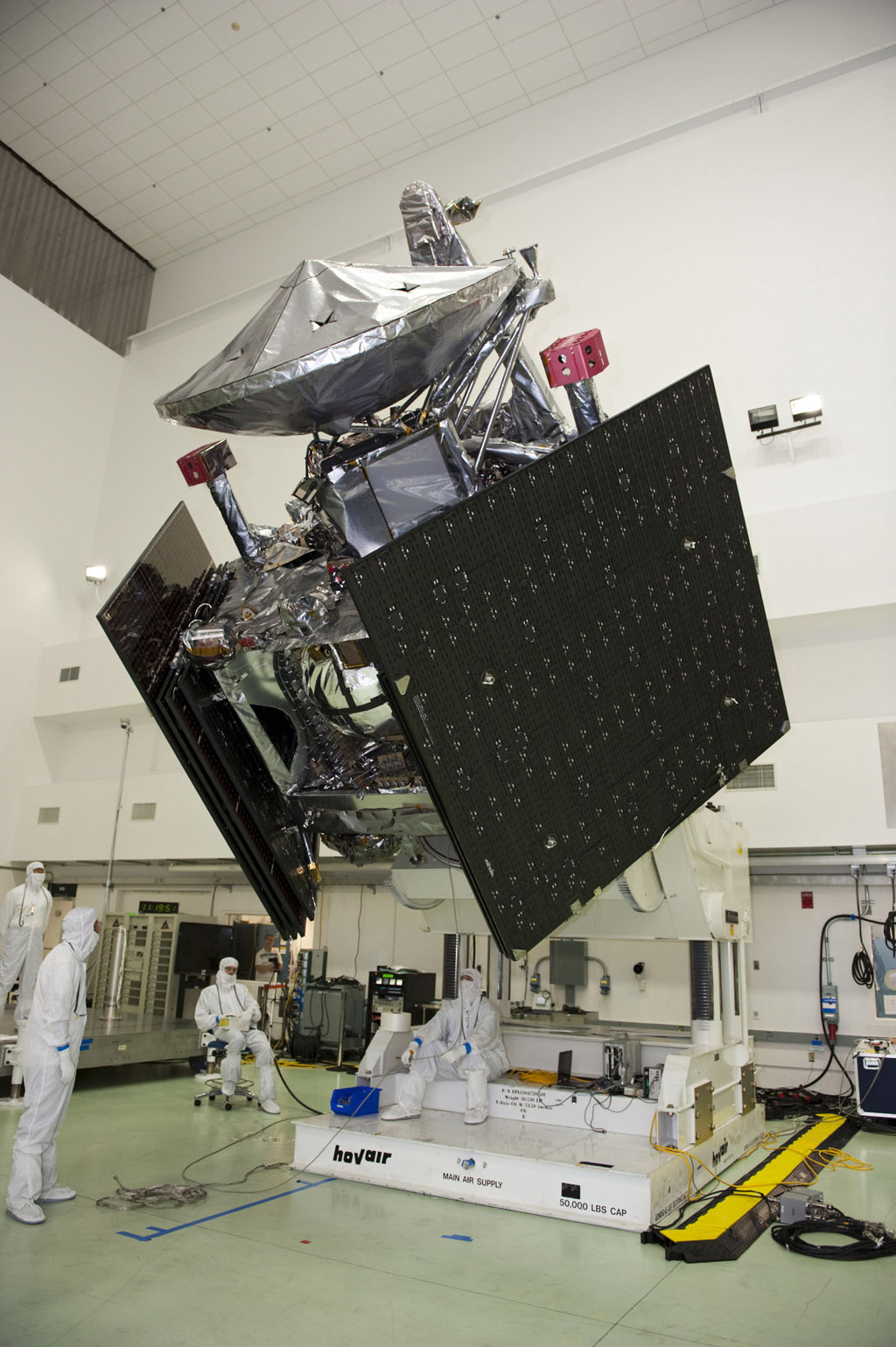
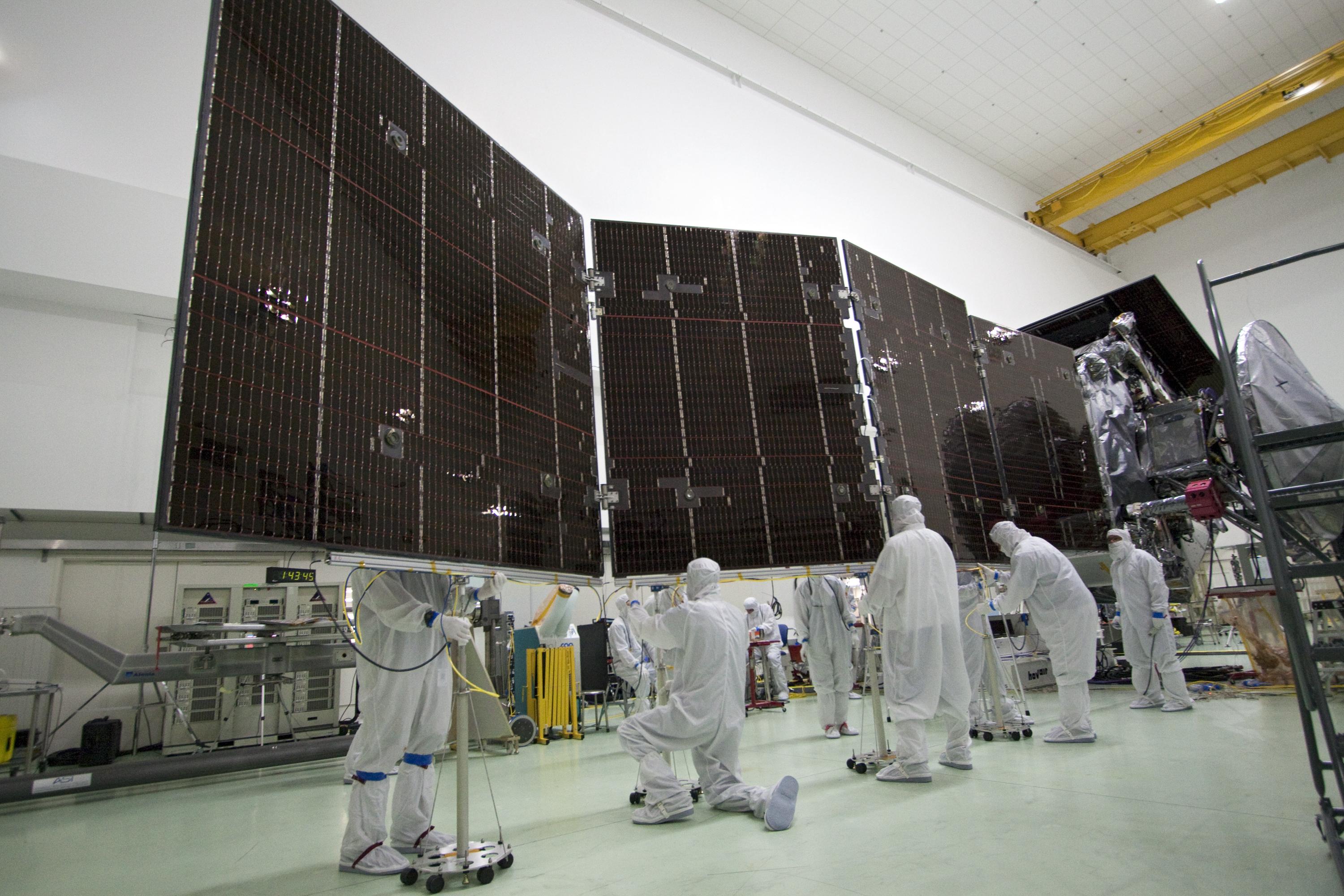
Ne čuh dobro: prvi video zapisi stižu ili za 7 ili za 17 dana.
Još dve slike koje dočaravaju dimenzije ove sonde i njena 3 solarna panela:


Re: Misterije svemira
7 dana za video zapise... Dovoljno vremena da se izbace svi škakljivi delovi. 
Najgore je svađati se sa budalom. Prvo te spusti na svoj nivo, a onda te dotuče iskustvom...



Re: Misterije svemira
Hm, tek kad tako neku cifru izbace skontas koliko je Suncev sistem veliki...a to nam je komsiluk
What i do for the livin'? I live for the livin'.
- H4wkeye
- Postovi: 8763
- Pridružio se: 12 Feb 2013, 02:48
- Garaža: Citroen C5 X7 Exclusive 2.0 HDI
- Lokacija: PO
Re: Misterije svemira
https://youtu.be/kjfQCTat-8s
Re: Misterije svemira
https://www.youtube.com/watch?v=UNlglX8 ... r_embedded
Najgore je svađati se sa budalom. Prvo te spusti na svoj nivo, a onda te dotuče iskustvom...



